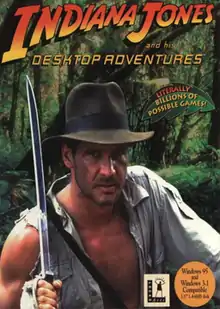Indiana Jones and His Desktop Adventures
Indiana Jones and His Desktop Adventures is a 1996 adventure video game. Desktop Adventures was made to run in a windowed form on the desktop to limit memory use and allow the player to perform other tasks. This game was the first Desktop Adventures game, and was followed by Star Wars: Yoda Stories in 1997.
| Indiana Jones and His Desktop Adventures | |
|---|---|
 The boxart for Indiana Jones and His Desktop Adventures features a still of Indiana Jones from Indiana Jones and the Temple of Doom | |
| Developer(s) | LucasArts |
| Publisher(s) | LucasArts |
| Director(s) | Hal Barwood |
| Designer(s) | Hal Barwood Wayne Cline Paul D. LeFevre Tom Payne |
| Programmer(s) | Paul D. LeFevre |
| Artist(s) | Tom Payne |
| Writer(s) | Hal Barwood Wayne Cline |
| Composer(s) | Clint Bajakian |
| Platform(s) | Microsoft Windows, Apple Macintosh |
| Release | April 1996[1] |
| Genre(s) | Adventure |
| Mode(s) | Single-player |
Plot
The game is set in mid-1930s Middle America with a variety of characters, puzzles, and outcomes. The plot, size, and direction of each game are randomly generated at the start, with locations and items being different every time, though each storyline has a pre-scripted resolution.
Gameplay

The playing area is displayed from an overhead perspective. The player-controlled Indiana Jones is limited to orthogonal movement, which is controlled with the arrow keys or with the mouse. The mouse is also used for other actions, such as managing inventory and using weapons. Each scenario is randomly generated by selecting each element (such as the item Indiana Jones must collect at each stage of the adventure) from a set of possibilities. After winning, the player can continue to explore the setting.
Reception
| Publication | Score |
|---|---|
| CGW | |
| GameSpot | 5.8/10 (PC)[3] |
| Next Generation | |
| PC Zone | 8/10 (PC)[5] |
| MacUser |
Trent Ward of GameSpot reviewed the game as having low-quality visuals and audio but being possibly useful for passing time.[3] Billboard magazine mentioned the game's randomly generated environment and its target audience of "gamers on the go", and deemed it "An unambitious title that will rope you in."[7] A Next Generation reviewer noted that the randomly generated scenarios are essentially repetitive, and complained at the fact that the player character cannot shoot diagonally but enemies can. He concluded, "All this said, however, the game only costs around 12 bucks and if you don't expect too much, it is pretty fun. The underlying idea is sound, and if you don't mind repetition, check it out."[4]
Charles Ardai of Computer Gaming World wrote, "For a genius, George Lucas sure has a lot of bad ideas. [...] Some time ago, someone from his computer game division must have come to him and said, 'Hey, let's put out a really simple, randomly generated RPG-style adventure game, stick a whip in the hand of the main character, use the Indiana Jones name–and make it look really ugly.' And Lucas must have said, 'Sounds good to me.'" Ardai wrote that Indiana Jones fans may enjoy the theme music featured in the game, but concluded that the game was, "Embarrassingly retro," with its "overly simplistic gameplay; crude visuals and sound" and "ludicrous ethnic stereotypes."[2]
Rob Tribe of PC Zone called it "very, very addictive," though like Next Generation, he criticized the fact that the player character cannot shoot diagonally but enemies can.[5]
In 1996, Computer Gaming World declared Indy's Desktop Adventures the 15th-worst computer game ever released.[8]
References
- "20th Anniversary - History; Part Three: Broadening Horizons, 1995 – 1998". LucasArts. Archived from the original on June 26, 2006.
- Ardai, Charles (August 1996). "A Compact Ford: Indiana Jones Meets His Doom In Desktop Adventures". Computer Gaming World. p. 128.
- Ward, Trent (1996-06-27). "Indiana Jones and his Desktop Adventures Review". GameSpot. Retrieved 2014-07-15.
- "Indiana Jones and his Desktop Adventures". Next Generation. No. 23. Imagine Media. November 1996. p. 281.
- Tribe, Rob (2001-08-13). "Indiana Jones And His Desktop Adventures". PC Zone. Archived from the original on 2007-09-15.
- Loyola, Roman (January 1997), "The Game Room", MacUser, archived from the original on February 21, 2001, retrieved January 23, 2020
- Atwood, Brett (1996-06-01). "Reviews & Previews". Billboard: 84. Retrieved 2014-07-15.
- Staff (November 1996). "150 Best (and 50 Worst) Games of All Time". Computer Gaming World (148): 63–65, 68, 72, 74, 76, 78, 80, 84, 88, 90, 94, 98.